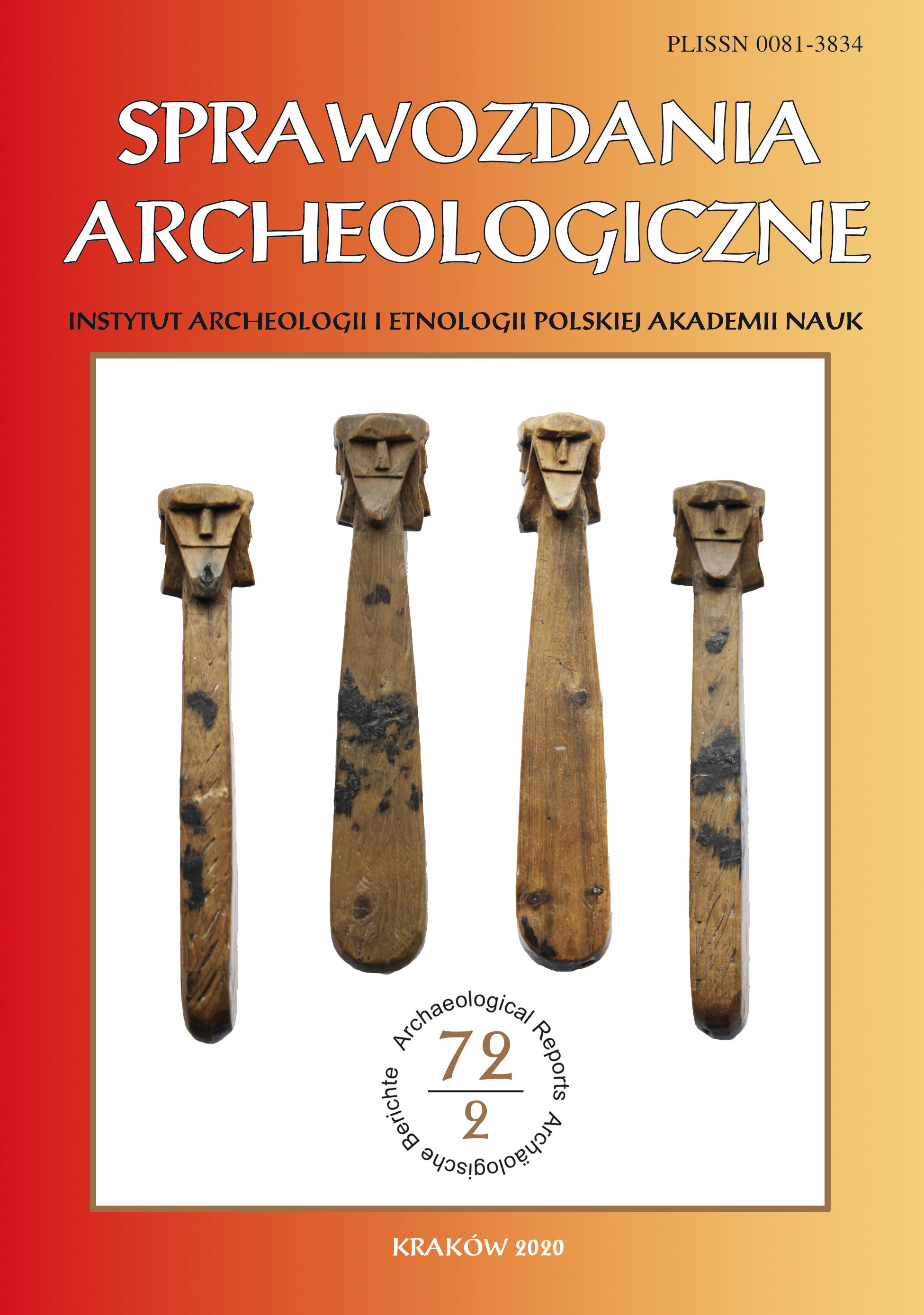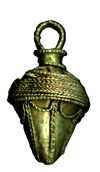“Raptus Sabinae?” complemented: molecular genetic studies on a female calvarium of the Bandkeramik settlement of Rovantsi in Volhynia (UA)
DOI:
https://doi.org/10.23858/SA/72.2020.2.1844Keywords:
ancient DNA (aDNA), human mitochondrial DNA haplogroup, DNA profiling, polymerase chain reaction (PCR), Early Neolithic, Bandkeramik (LBK), UkraineAbstract
A fragmented human cranial calotte was discovered in a Bandkeramik (LBK) settlement context at Rovantsi in Volhynia (UA). The female calvarium of a mature woman with an age of about 45-50 years was uncovered in the deepest part of a settlement pit. It can be dated to round about 5,250 BC. PCR-based molecular genetic analyses were successfully performed on these extremely rare skeletal remains from the Early Neolithic of Ukraine. The female family line can be assigned to haplogroup T2, in which it represents the lineage T2c1d+152. The woman was lactose intolerant, like most LBK individuals. Her hair colour was brown, and her eye colour was found to be hazel.
Downloads
References
Bardetskiy A. B., Dębiec M., Potekhina I. D. and Saile T. 2017. Raptus Sabinae? Of a female calvarium from the Bandkeramik settlement of Rovantsi in Volhynia. Sprawozdania Archeologiczne 69, 235-251.
Brandt G., Haak W., Adler C. J., Roth C., Szécsényi-Nagy A., Karimnia S., Möller-Rieker S., Meller H., Ganslmeier R., Friederich S., Dresely V., Nicklisch N., Pickrell J. K., Sirocko F., Reich D., Cooper A., Alt K. W. and Genographic Consortium. 2013. Ancient DNA reveals key stages in the formation of central European mitochondrial genetic diversity. Science. 2013 Oct 11; 342(6155), 257-261.
Butler J. M. (ed.) 2015.Advanced Topics in Forensic DNA Typing: Interpretation. San Diego, CA, USA: Academic Press.
Cerqueira C. C. S., Paixăo Côrtes V. R., Zambra F. M. B., Salzano F. M., Hünemeier T. and Bortolini M.C. 2012. Predicting homo pigmentation phenotype through genomic data: From neanderthal to James Watson. American Journal of Human Biology 24(5), 705-709.
Chaitanya L., Breslin K., Zuńiga S., Wirken L., Pospiech E., Kukla-Bartoszek M., Sijen T., de Knijff P., Liu F., Branicki W., Kayser M. and Walsh S. 2018. The HIrisPlex-S system for eye, hair and skin colour prediction from DNA: Introduction and forensic developmental validation. Forensic Science International Genetics 35, 123-135.
Dębiec M. and Saile T. 2015. Zu den östlichsten Siedlungen der frühen Bandkeramik. Praehistorische Zeitschrift 90, 1-19.
Deng L. and Xu S. 2018. Adaptation of human skin color in various populations. Hereditas (2018) 155:1.
Enattah N. S., Sahi T., Savilahti E., Terwilliger J. D., Peltonene L. and Järvelä I. 2002. Identification of a variant associated with adult-type hypolactasia. Nature Genetics 30, 233-237.
Fehren-Schmitz L., Reindel M., Cagigao E. T., Hummel S. and Herrmann B. 2010. Pre-Columbian population dynamics in coastal southern Peru. A diachronic investigation of mtDNA pattern in the Palpa region by ancient DNA analysis. American Journal of Physical Anthropology 141(2), 208-221.
Flux A. L., Mazanec J., Strommenger B. and Hummel S. 2017. Staphylococcus aureus Sequences from Osteomyelitic Specimens of a Pathological Bone Collection from Pre-Antibiotic Times. Diversity 9, 43.
Frischalowski M., Seidenberg V., Grosskopf B., Wulf F. W. and Hummel S. 2015. Molekulargenetische Untersuchung des Verwandtschaftsverhältnisses von möglichen Mutter-Kind-Bestattungen aus dem frühneuzeitlichen Eldagsen. Nachrichten aus Niedersachsens Urgeschichte 84, 193-206.
Fulge M. 2005. Laktosetoleranz in der bronzezeitlichen Lichtensteinhöhle – Molekulargenetischer Nachweis des Polymorphismus C/T 13910 an prähistorischer DNA. Göttingen 2005 [unpublished state examination thesis].
Haak W., Forster P., Bramanti B., Matsumura S., Brandt G., Tänzer M., Villems R., Renfrew C., Gronenborn D., Alt K. W. and Burger J. 2005. Ancient DNA from the first European farmers in 7500-year-old Neolithic sites. Science 310(5750), 1016-1018.
Haak W., Balanovsky O., Sanchez J. J., Koshel S., Zaporozhchenko V., Adler C. J., Der Sarkissian C. S. I., Brandt G., Schwarz C., Nicklisch N., Dresel V., Fritsch B., Balanovska E., Villems R., Meller H., Alt K. W., Cooper A. and the Genographic Consortium. 2010. Ancient DNA from European Early Neolithic Farmers Reveals Their Near Eastern Affinities. PLoS Biol. 2010 Nov 9;8(11): e1000536.
Hofreiter M., Jaenicke V., Serre D., von Haeseler A. and Pääbo S. 2001. DNA sequences from multiple amplifications reveal artifacts induced by cytosine deamination in ancient DNA. Nucleic Acids Res. 29(23), 4793-4799.
Hummel S. 2003. Ancient DNA Typing. Methods, Strategies, and Applications. Berlin, Heidelberg: Springer.
Kayser M. 2015. Forensic DNA Phenotyping: Predicting human appearance from crime scene material for investigative purposes. Forensic Science International: Genetics 18, 33-48.
Mathieson I., Lazaridis I., Rohland N., Mallick S., Patterson N., Roodenberg S., Harney E., Stewardson K., Fernandes D., Novak M., Sirak K., Gamba C., Jones E., Llamas B., Dryomov S., Pickrell J., Arsuaga J., Bermúdez de Castro J.-M., Carbonell E., Gerritsen F., Khokhlov A., Kuznetsov P., Lozano M., Meller H., Mochalov O., Moiseyev V., Guerra M. A. R., Roodenberg J., Vergčs J. M., Krause J., Cooper A., Alt K.W., Brown D., Anthony D., Lalueza-Fox C., Haak W., Pinhasi R. and Reich D. 2015. Genome-wide patterns of selection in 230 ancient Eurasians. Nature 528(7583), 499-503.
Olalde I., Allentoft M. E., Sánchez-Quinto F., Santpere G., Chiang C. W. K., DeGiorgio M., Prado-Martínez J., Rodríguez J. A., Rasmussen S., Quilez J., Ramírez O., Marigorta U. M., Fernández-Callejo M., Prada M. E., Encinas J. M. V., Nielsen R., Netea M. G., Novembre J., Sturm R. A., Sabeti P., Marqučs-Bonet T., Navarro A., Willerslev E. and Lalueza-Fox C. 2014. Derived Immune and Ancestral Pigmentation Alleles in a 7,000-Year-old Mesolithic European. Nature 2014 March 13; 507(7491).
Pala M., Olivieri A., Achilli A., Accetturo M., Metspalu E., Reidla M., Tamm E., Karmin M., Reisberg T., Hooshiar Kashani B., Perego U. A., Carossa V., Gandini F., Pereira J. B., Soares P., Angerhofer N., Rychkov S., Al-Zahery N., Carelli V., Sanati M. H., Houshmand M., Hatina J., Macaulay V., Pereira L., Woodward S. R., Davies W., Gamble C., Baird D., Semino O., Villems R., Torroni A. and Richards M. B. 2012. Mitochondrial DNA signals of late glacial recolonization of Europe from near eastern refugia. American Journal of Human Genetics 90(5), 915-924.
Parson W. and Dür A. 2007. EMPOP – A forensic mtDNA database. Forensic Science International: Genetics 1(2), 88-92. https://empop.online/.
Phillips C., Salas A., Sánchez J. J., Fondevila M., Gómez-Tato A., Álvarez-Dios J., Calaza M., Casares de Cal M., Ballard D., Lareu M. V., Carracedo Á. and The SNPforID Consortium. 2007. Inferring ancestral origin using a single multiplex assay of ancestry-informative marker SNPs. Forensic Science International: Genetics 1(3-4), 273-280. www.http://mathgene.usc.es/snipper/.
Saile Th., Sedlmaier H. and Dębiec M. 2018. Šárka in Wolhynien und in Bayern. Ein Beitrag zu spätbandkeramischen Dreiecksintarsien. Archäologisches Korrespondenzblatt 48, 27-38.
Schmidt N., Schücker K., Krause I., Dörk T., Klintschar M. and Hummel S. 2020. Genome-wide SNP typing of ancient DNA – Determination of hair and eye colour of Bronze Age humans from their skeletal remains. American Journal of Physical Anthropology 2020, 1-11.
Seebode C. 2010. Das Skelettkollektiv der Lichtensteinhöhle als genetisches Archiv – Untersuchungen des Laktosetoleranzmarkers C/T13910 an den bronzezeitlichen Individuen. Göttingen 2010 [unpublished diploma thesis].
Seidenberg V. 2016. Ein bronzezeitlicher Familienclan als genetisches Archiv – Morphologisch-paläogenetische Bearbeitung des Skelettkollektivs aus der Lichtensteinhöhle. Göttingen 2016 [unpublished PhD thesis].
Seidenberg V., Schilz F., Pfister D., Georges L., Fehren-Schmitz L. and Hummel S. 2012. A new miniSTR heptaplex system for genetic fingerprinting of ancient DNA from archaeological human bone. Journal of Archaeological Science 39, 2012, 3224-3229.
Söchtig J., Phillips C., Marońas O., Gómez-Tato A., Cruz R., Alvarez-Dios J., Casares de Cal M.-Á., Ruiz Y., Reich K., Fondevila M., Carracedo Á. and Lareu M. V. 2015. Exploration of SNP variants affecting hair colour prediction in Europeans. International Journal of Legal Medicine 129(5), 963-975.
Strien H.-C. 2018.Westexpansion und Regionalisierung der Ältesten Bandkeramik (= Kommunikation und Wandel. Monographien zu Entwicklungen in der Urgeschichte 1). Kerpen-Loogh: Welt und Erde Verlag.
Downloads
Published
How to Cite
Issue
Section
License
Copyright (c) 2020 Sprawozdania Archeologiczne

This work is licensed under a Creative Commons Attribution 4.0 International License.














